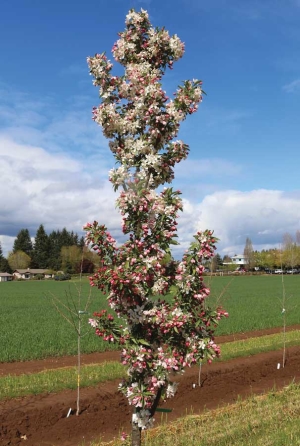For decades, apple growers have used Manchurian crab apples to pollinate their fruit.

Tree fruit researchers are searching for new pollinizer trees as alternatives to the Manchurian crab apple, such as this one at a Boring, Oregon, nursery. (Courtesy Stefano Musacchi/WSU)
The crab apples bloom early, and Snowdrift apples bloom a little later. Between the two, orchardists figured they had their bases covered.
Now, a Wenatchee, Washington, researcher says there is more to it. He is searching for new pollinizer trees to give growers more genetically precise alternatives, specifically those that resist rot.
“Think about the biology of your pollinizers,” said Dr. Stefano Musacchi, tree fruit physiologist at Washington State University’s Tree Fruit Research and Extension Center in Wenatchee.
Musacchi is part of a team of researchers working under a five-year, $1.9 million grant from the U.S. Department of Agricultural Foreign Agricultural Service Technical Assistance for Specialty Crops program.
The work was triggered by a 2012 international trade incident, when Chinese inspectors shut down U.S. imports for two years after they found three types of rot on a shipment of Washington apples.
Musacchi’s colleagues, Dr. Karen Lewis, Dr. Mark Mazzalo, Dr. Parama Sikdar and doctoral student Christian Aguilar, are looking for ways to control the rot through pruning techniques and post-harvest fumigations. Their work helped persuade Chinese authorities to reopen their ports in November 2014.
At the same time, the industry must think ahead, Musacchi said. The research team is searching for long-term options for not only rot problems, but also pollen compatibility, tree shape and bloom dates.
Too often, growers plant pollinizers as an afterthought, choosing what they’ve always used out of habit, Musacchi said.
He urges them to be more discerning, making sure pollinizer trees line up with the DNA of the crop tree.
For example, Manchurian crab apples have pollen that is partially incompatible with several important commercial apple varieties, such as Red Delicious, Gala and Honeycrisp.
Most varieties of cultivars and pollinizers have two alleles, the genetic markers in pollen. For fertilization, alleles must be different between pollinizer and fruit flower, hence the term “cross-pollination.”
Working with J. Franck Schmidt and Son Nursery in Boring, Oregon, Musacchi has collected 30 genotypes of crab apples he keeps in pots in the Research and Extension Center’s greenhouse, though he plans to plant some in the ground at the center’s Sunrise research orchard east of Wenatchee.
He will tend 143 trees of each strain, crushing their leaves to find the genetic markers, and study when they bloom, the size of their fruit, the shape of the tree, resistance to disease and other characteristics.
His goal is to find two to three pollinizer genotypes that best match each of the industry’s main commercial cultivars.
“Because everybody was using some genotype as a habit but not really with a scientific base of knowledge,” Musacchi said. •
– by Ross Courtney






Leave A Comment